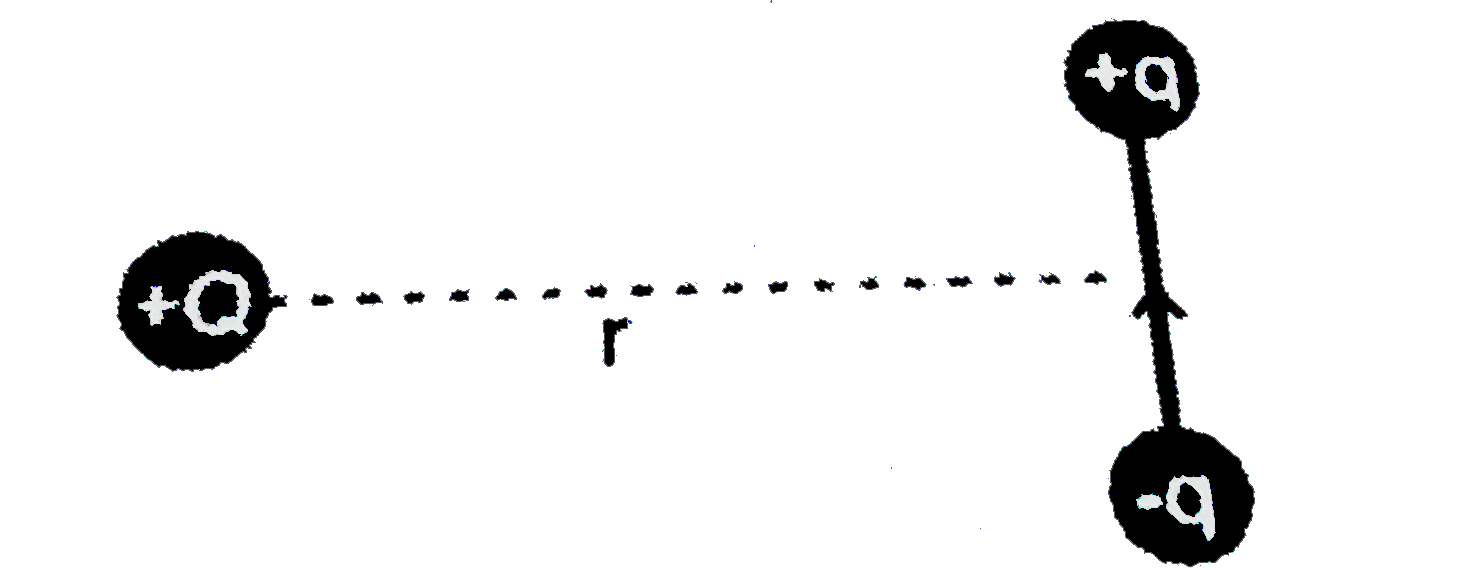Two equal charges of opposite sign separated by a distance 2a constitute an electric dipole of dipole moment . If P is a point at a distance r from the centre of the dipole and the line joining the centre of the dipole to this point makes an angle with the axis of the dipole, then then potential at P is given by where (p = 2 qa)
The correct Answer is:B
To solve the problem, we need to find the electric potential V at a point P due to an electric dipole consisting of two equal and opposite charges +q and −q separated by a distance 2a. The dipole moment p is given by p=2qa.
1. Understanding the Dipole Configuration:
- We have two charges: +q and −q separated by a distance 2a.
- The dipole moment p is defined as p=q⋅d, where d is the separation between the charges. Here, d=2a, so p=2qa.
2. Positioning the Dipole:
- Place the dipole along the x-axis with the positive charge at (−a,0) and the negative charge at (a,0).
- The center of the dipole is at the origin (0,0).
3. Identifying the Point P:
- The point P is at a distance r from the center of the dipole.
- The line joining the center of the dipole to point P makes an angle θ with the dipole axis (x-axis).
4. Calculating the Electric Potential:
- The electric potential V due to a dipole at a point in space is given by the formula:
V=14πϵ0⋅pcosθr2
- Here, ϵ0 is the permittivity of free space.
5. Substituting the Dipole Moment:
- Substitute p=2qa into the potential formula:
V=14πϵ0⋅2qacosθr2
6. Final Expression:
- Thus, the electric potential V at point P is:
V=2qacosθ4πϵ0r2
Conclusion:
The potential at point P due to the dipole is given by:
V=pcosθ4πϵ0r2
where p=2qa.
- We have two charges: +q and −q separated by a distance 2a.
- The dipole moment p is defined as p=q⋅d, where d is the separation between the charges. Here, d=2a, so p=2qa.
- Place the dipole along the x-axis with the positive charge at (−a,0) and the negative charge at (a,0).
- The center of the dipole is at the origin (0,0).
- The point P is at a distance r from the center of the dipole.
- The line joining the center of the dipole to point P makes an angle θ with the dipole axis (x-axis).
- The electric potential V due to a dipole at a point in space is given by the formula:
V=14πϵ0⋅pcosθr2
- Here, ϵ0 is the permittivity of free space.
- Substitute p=2qa into the potential formula:
V=14πϵ0⋅2qacosθr2
- Thus, the electric potential V at point P is:
V=2qacosθ4πϵ0r2
The potential at point P due to the dipole is given by:
V=pcosθ4πϵ0r2
where p=2qa.
Topper's Solved these Questions
- ELECTROSTATIC POTENTIAL AND CAPACITORSBOOK - DC PANDEY ENGLISHCHAPTER - ELECTROSTATIC POTENTIAL AND CAPACITORSEXERCISE - (B) Chapter exercises
17 Videos
- ELECTROSTATIC POTENTIAL AND CAPACITORSBOOK - DC PANDEY ENGLISHCHAPTER - ELECTROSTATIC POTENTIAL AND CAPACITORSEXERCISE - (C) Chapter exercises
50 Videos
- ELECTROSTATIC POTENTIAL AND CAPACITORSBOOK - DC PANDEY ENGLISHCHAPTER - ELECTROSTATIC POTENTIAL AND CAPACITORSEXERCISE - Check point 2.5
20 Videos
- ELECTROMAGNETIC WAVESBOOK - DC PANDEY ENGLISHCHAPTER - ELECTROMAGNETIC WAVESEXERCISE - Sec C
22 Videos
- ELECTROSTATICSBOOK - DC PANDEY ENGLISHCHAPTER - ELECTROSTATICSEXERCISE - Medical entrances gallery
37 Videos
Similar Questions
The electric field of an electric dipole at a point on its axis , at a distance d from the centre of the dipole, varies as
View SolutionWhat is the magnitude of electric intensity due to a dipole of moment 2×10−8C−m at a point distant 1m from the centre of dipole, when line joining the point to the center of dipole makes an angle of 60∘ with dipole axis ?
View SolutionAn electric dipole of dipole moment p is placed in a uniform external electric field E. Then, the
View SolutionThe potential at a point due to an electric dipole will be maximum and minimum when the angles between the axis of the dipole and the line joining the point to the dipole are respectively
View SolutionA short dipole of dipole moment P is placed near a point charge Q as shown in figure. Find force on the dipole due to the point charge

View SolutionA short dipole of dipole moment P is placed near a point charge Q as shown in figure. Find force on the dipole due to the point charge

View SolutionA point Q lies on the perpendicular bisector of an electrical dipole of dipole moment p, If the distance of Q from the dipole is r (much larger than the size of the dipole), then electric field at Q is proportional to
View SolutionA tiny electric dipole of dipole moment p is palced at a distance r from an infinitely long wire, with its →p normal to the wire. If the linear charge density of the wire is λ, the electrostatic force acting on the dipole is equal to
View SolutionAn electric dipole is placed at the origin O and is directed along the x-axis. At a point P, far away from the dipole, the electric field is parallel to y-axis. OP makes an angle θ with the x-axis then
View SolutionAn electric dipole is placed at the origin O and is directed along the x-axis. At a point P, far away from the dipole, the electric field is parallel to y-axis. OP makes an angle θ with the x-axis then
View Solution
